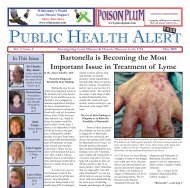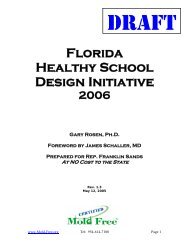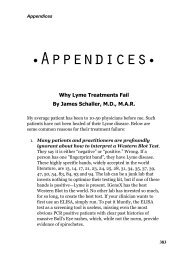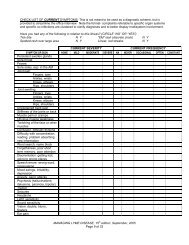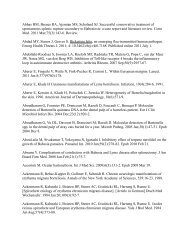- Page 1 and 2:
Environmentally FriendlyMold Remedi
- Page 3 and 4:
Environmentally FriendlyMold Remedi
- Page 5:
Environmentally Friendly Mold Remed
- Page 8 and 9:
Environmentally Friendly Mold Remed
- Page 10 and 11:
Susceptibility to Asthma Controlled
- Page 12 and 13: Environmentally Friendly Mold Remed
- Page 14 and 15: Environmentally Friendly Mold Remed
- Page 16 and 17: Environmentally Friendly Mold Remed
- Page 18 and 19: Environmentally Friendly Mold Remed
- Page 20 and 21: Environmentally Friendly Mold Remed
- Page 22 and 23: Environmentally Friendly Mold Remed
- Page 24 and 25: Environmentally Friendly Mold Remed
- Page 26 and 27: Environmentally Friendly Mold Remed
- Page 28 and 29: The following photo-micrographic pi
- Page 30 and 31: ASPERGILLUS ochraceousALLERGENICITY
- Page 33 and 34: ASPERGILLUS nigerALLERGENICITY:Alle
- Page 35: FUSARIUM sp.ALLERGENICITY:MYCOTOXIN
- Page 38 and 39: Environmentally Friendly Mold Remed
- Page 40 and 41: Environmentally Friendly Mold Remed
- Page 42 and 43: Environmentally Friendly Mold Remed
- Page 44 and 45: Environmentally Friendly Mold Remed
- Page 47 and 48: Environmentally Friendly Mold Remed
- Page 49 and 50: Environmentally Friendly Mold Remed
- Page 51 and 52: Environmentally Friendly Mold Remed
- Page 53 and 54: Environmentally Friendly Mold Remed
- Page 55: Environmentally Friendly Mold Remed
- Page 58 and 59: Environmentally Friendly Mold Remed
- Page 60 and 61: Environmentally Friendly Mold Remed
- Page 64 and 65: Environmentally Friendly Mold Remed
- Page 66 and 67: Environmentally Friendly Mold Remed
- Page 68 and 69: Environmentally Friendly Mold Remed
- Page 70 and 71: Environmentally Friendly Mold Remed
- Page 72 and 73: Environmentally Friendly Mold Remed
- Page 74 and 75: Environmentally Friendly Mold Remed
- Page 76 and 77: Environmentally Friendly Mold Remed
- Page 78 and 79: Environmentally Friendly Mold Remed
- Page 80 and 81: Environmentally Friendly Mold Remed
- Page 82 and 83: Environmentally Friendly Mold Remed
- Page 84 and 85: Environmentally Friendly Mold Remed
- Page 86 and 87: Environmentally Friendly Mold Remed
- Page 88 and 89: Environmentally Friendly Mold Remed
- Page 90 and 91: Environmentally Friendly Mold Remed
- Page 92 and 93: Environmentally Friendly Mold Remed
- Page 94 and 95: Environmentally Friendly Mold Remed
- Page 96 and 97: Environmentally Friendly Mold Remed
- Page 98 and 99: Environmentally Friendly Mold Remed
- Page 100 and 101: Environmentally Friendly Mold Remed
- Page 102 and 103: Environmentally Friendly Mold Remed
- Page 104 and 105: Environmentally Friendly Mold Remed
- Page 106 and 107: Environmentally Friendly Mold Remed
- Page 108 and 109: Certified Mold Free Construction288
- Page 110 and 111: Certified Mold Free Construction288
- Page 112 and 113:
Certified Mold Free Construction288
- Page 114 and 115:
Certified Mold Free Construction288
- Page 116 and 117:
Certified Mold Free Construction288
- Page 118 and 119:
Certified Mold Free Construction288
- Page 120 and 121:
Environmentally Friendly Mold Remed
- Page 122 and 123:
Environmentally Friendly Mold Remed
- Page 125 and 126:
Environmentally Friendly Mold Remed
- Page 127 and 128:
Environmentally Friendly Mold Remed
- Page 129 and 130:
Environmentally Friendly Mold Remed
- Page 131 and 132:
Environmentally Friendly Mold Remed
- Page 133 and 134:
Environmentally Friendly Mold Remed
- Page 135 and 136:
Environmentally Friendly Mold Remed
- Page 137 and 138:
Environmentally Friendly Mold Remed
- Page 139:
Environmentally Friendly Mold Remed
- Page 142 and 143:
White’s Second LawThe majority of
- Page 144 and 145:
Too Toxic to Use? Cont’d Some tim
- Page 146 and 147:
Green or Non-ToxicMany ‘Green’
- Page 148 and 149:
Cleaning Processes Washing can get
- Page 150 and 151:
RinsingRinsing is just as important
- Page 152 and 153:
Bleaching for EffectIf the surfaces
- Page 154 and 155:
Sealing of Cavities Sealing should
- Page 156 and 157:
Warrantees on Cleaning Warrantees o
- Page 158 and 159:
Ventilation & Humidity ControlAlmos
- Page 160 and 161:
Environmentally Friendly Mold Remed
- Page 162 and 163:
Environmentally Friendly Mold Remed
- Page 164:
Environmentally Friendly Mold Remed





